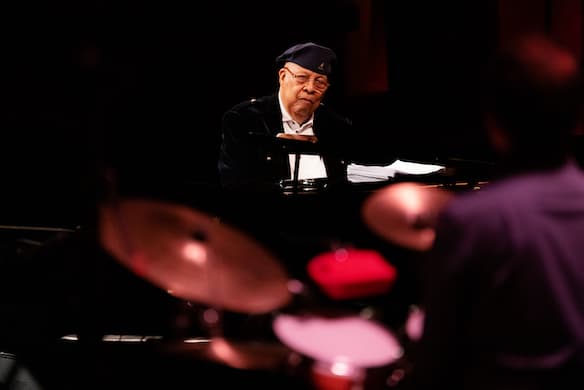Even at 81, Chucho Valdés Stands Tall in More Ways Than One
His work fulfills the mandate of Jazz at Lincoln Center: It’s an extended composition for the concert stage yet it has the house on its feet cheering in a way that formal symphonic music doesn’t always do.

Chucho Valdés commands the stage just by walking out onto it. He’s a giant of a musician, in more ways than one, being part of the small cadre of larger-than-life piano colossi — along with the late Randy Weston and Paul Smith — whose physical stature seems like a direct manifestation of their talent. Like Duke Ellington, he’s always the tallest guy in his band, and that’s no small thing.
Señor Valdés turns 81 October 10, and he celebrated his birthday this weekend at Jazz at Lincoln Center’s Rose Hall, in a live-streamed concert that is viewable via Jazz Live, the new streaming platform for JALC.
Like his colleagues, Chico and Arturo O’Farrill, Señor Valdés is part of a Cuban musical dynasty; both his late father, Bebo, and his son, Chuchito, are prominent pianists, and Chucho has been making music for nearly all of those 81 years. That’s plenty of time for him to learn almost everything there is to know about how to compose music, how to arrange it and put it all together with a band of musicians, and how to perform and present it for maximum impact in front of an appreciative crowd.
The JALC concert, which was titled “Creation,” began with an original solo piece that served as an introduction to the evening. Still playing unaccompanied, he followed with a medley of standard ballads that, as some of us noticed, were mostly all by legendary pianist-composers: Bill Evans’s “Waltz For Debby,” George Gershwin’s “Someone to watch over me,” and Guy Woods’s “My one and only love.”
Then he was joined by the rest of his quartet — bassist Jose Gola, percussionist Roberto Vizcaino, and drummer Dafnis Prieto — as he lunged into an uptempo concoction that centered on Gershwin’s “But Not For Me,” with detours through Billy Strayhorn’s “Take the A Train” and Paul Desmond’s “Take Five.” Again, mostly by pianists.
That was the prelude to an hour or so of original Afro Cuban music played by Señor Valdés and his large-format group, sort of an expanded version of the ensemble he normally calls “The Afro Cuban Jazz Messengers.”
In this case there were two trumpeters, Brian Lynch and Michael Rodriguez; and two multi-reed players, Marcus Strickland, who played mostly alto saxophone, and Carlos Averoff, Jr., who played mostly tenor. Then there were four performers who played additional percussion and sang, listed in the program as “Santiera Chants,” Erick Barberia, Yosvani Gonsalves, “Coki” Sarria Linares, and Yensel Valdés. The ensemble was completed by Hilario Duran and John Beasley, who both played additional keyboards and occasionally conducted. (Mr. Beasley also became a defacto horn player with a souped-up melodica, essentially a wind-driven synthesizer.)
The two most salient features of “Creation” are rhythm and variety, including portions in 6/8, 4/4, 3/4, and even 5/4. This is essentially a work in the Afro Cuban jazz idiom, but parts of it are more overtly Afro Cuban than others. In fact, one very effective technique Señor Valdés uses is to have a long sequence where the rhythm is downplayed, then to bring it back on in full force into Cuban clave as he shifts into another section. Some movements feature the Santiera chanters, while others are completely instrumental; there’s never too much of any one thing.
Among other segments, there were extended solos for all three of the other members of the quartet — including the bassist, who switched to electric about halfway through the evening, and both drummers. All soloed a capella, as did the four horn players. Pertinently, after his mostly solo introduction to “Creation,” Señor Valdés hardly soloed at all: He had already cast his authoritative stamp all over the entire work.
I’m looking forward to “Creation” being released as an album, if it happens, so I can delve into the individual segments. There was a lovely waltz ballad about halfway through in which both brassmen switched to flugelhorn — Señor Rodriguez played the melody, while Messrs. Averoff and Strickland played a lush background on flute and bass clarinet, respectively.
The single-act performance concluded with a generous and genuinely surprising encore, which he introduced en espanol as “Bacalao” (a Spanish seafood dish), bringing out as guests stars the clarinetist Paquito D’Rivera and the trumpeter Nicholas Payton, who raised the roof even further.
In short, this is a work that fulfills the mandate of Jazz at Lincoln Center: It’s an extended composition for the concert stage — it belongs in a big room rather than a nightclub — yet it has the house on its feet cheering (and wishing there were space to dance) in a way that formal symphonic music doesn’t always do, and not just at the ending. That too is no small thing.

